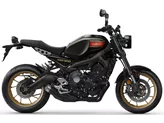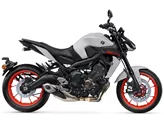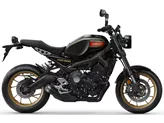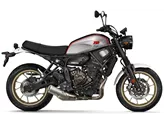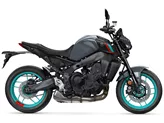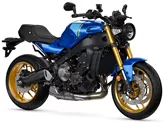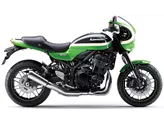Suzuki GSR 750 2013 vs. Yamaha XSR900 2016

Suzuki GSR 750 2013

Yamaha XSR900 2016
Visão geral - Suzuki GSR 750 2013 vs Yamaha XSR900 2016
The Suzuki GSR 750 2013 and the Yamaha XSR900 2016 are both naked bikes with similar technical specifications. They both have an inline engine type and a double tube frame. However, there are some notable differences between the two models.
In terms of power, the Yamaha XSR900 2016 has a slight advantage with 115 HP compared to the Suzuki GSR 750 2013's 106 HP. The Yamaha also has a higher torque of 87.5 Nm compared to the Suzuki's 80 Nm. This difference in power and torque can result in a more thrilling and responsive riding experience on the Yamaha.
In terms of engine configuration, the Suzuki GSR 750 2013 has a 4-cylinder engine, while the Yamaha XSR900 2016 has a 3-cylinder engine. The Suzuki has a displacement of 749cc, while the Yamaha has a slightly larger displacement of 847cc. This difference in engine configuration and displacement can result in differences in power delivery and overall performance.

Suzuki GSR 750 2013
When it comes to the chassis, the Yamaha XSR900 2016 has an aluminum frame, which is generally lighter and more rigid compared to the steel frame of the Suzuki GSR 750 2013. This can contribute to better handling and maneuverability on the Yamaha.
In terms of braking, both models have double disc brakes at the front. However, the Suzuki GSR 750 2013 is criticized for having weak brakes, while the Yamaha XSR900 2016 is praised for having a well-tuned ABS system.
In terms of dimensions and weights, both models have the same tire width and diameter at the front and rear. The Suzuki GSR 750 2013 has a slightly longer wheelbase at 1450mm compared to the Yamaha XSR900 2016's 1440mm. The seat height is the same for both models at 815mm. However, the Yamaha is lighter with a curb weight of 188kg compared to the Suzuki's 211kg.
In terms of fuel capacity, the Suzuki GSR 750 2013 has a larger capacity at 17.5 liters compared to the Yamaha XSR900 2016's 14 liters. This can result in a longer riding range on the Suzuki.

Yamaha XSR900 2016
In terms of strengths, the Suzuki GSR 750 2013 is praised for its good ergonomics, powerful engine, ABS system, and easy-to-read instruments. On the other hand, the Yamaha XSR900 2016 is praised for its eager engine, well-tuned riding modes, standard ABS and TC, modern and authentic design, and clean finish.
In terms of weaknesses, the Suzuki GSR 750 2013 is criticized for having weak brakes, a cheap-looking square swingarm, and suspension elements without adjustment capabilities. The Yamaha XSR900 2016 is criticized for having a rigid chassis, a less comfortable seat, and a speed block design that is not unique to the model.
Overall, both the Suzuki GSR 750 2013 and the Yamaha XSR900 2016 have their own strengths and weaknesses. The choice between the two models ultimately depends on the rider's preferences and priorities.
Especificações técnicas Suzuki GSR 750 2013 em comparação com Yamaha XSR900 2016
Prós e contras em comparação
Prós e contras em comparação
Suzuki GSR 750 2013

Devido à falta de possibilidades de regulação, o chassis é um bom compromisso.
Yamaha XSR900 2016

A XSR900 combina o desempenho de uma streetfighter desportiva com o visual de uma naked retro agradável e com acabamentos limpos. Ao fazê-lo, os japoneses fazem uso da sua própria história, que pode ser encontrada em conjunto e sem lacunas no arquivo da agência de design que trabalha para a Yamaha há 60 anos. Adopta as virtudes da MT-09 e corrigiu algumas das suas fraquezas. A sua condução é mais harmoniosa, mais controlada e, se desejado, mais descontraída. Apenas o conforto, e portanto o piloto, sofre com o chassis apertado em estradas más. É preciso ser um pouco sensível quando se trata de uma neo-clássica.
Comparação de preços Preço médio de mercado Suzuki GSR 750 vs Yamaha XSR900
There are a few key differences between a Suzuki GSR 750 2013 and a Yamaha XSR900 2016. In terms of price, the actual average price of a Yamaha XSR900 2016 is about 10% higher. A Suzuki GSR 750 2013 experiences a loss of 5.360 BRL in one year and 6.180 BRL in two years of ownership. This is offset by a loss of 11.090 BRL and 11.200 BRL for a Yamaha XSR900 2016. Compared to Yamaha XSR900 2016 there are more Suzuki GSR 750 2013 bikes available on the 1000PS.de Marketplace, specifically 10 compared to 5. It takes less time to sell a Suzuki GSR 750 with 58 days compared to 77 days for a Yamaha XSR900. Since model year 2011 1000PS.de editors have written 12 reviews for the Suzuki GSR 750 and 30 reviews for the Yamaha XSR900 since model year 2016. The first review for the Suzuki GSR 750 was published on 05/10/2010 and now has more than 5.400 views. This compares to more than 17.600 views for the first review on Yamaha XSR900 published on 25/11/2015.



